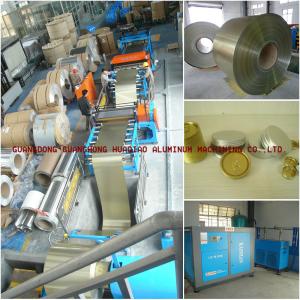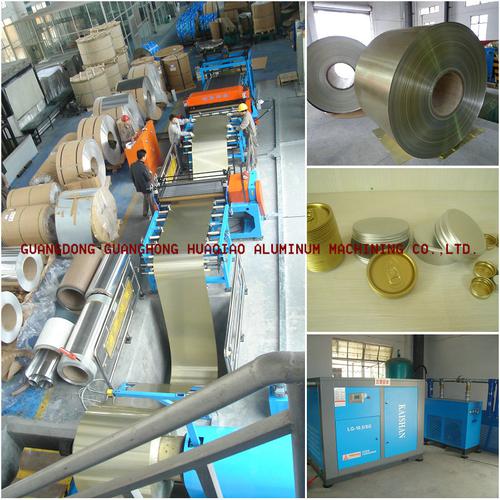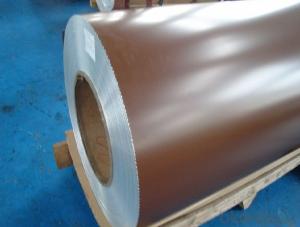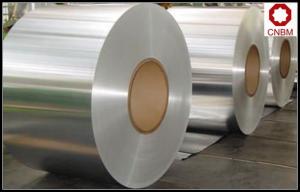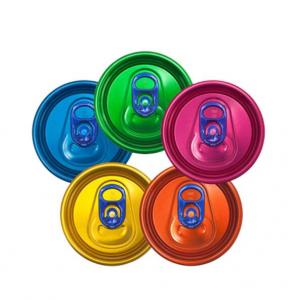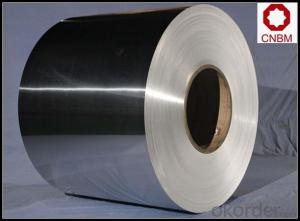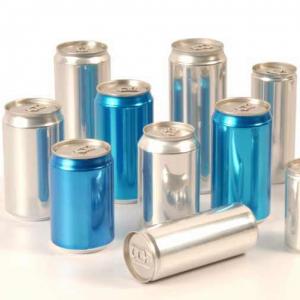China Aluminum Coil Can End Stock
- Loading Port:
- China Main Port
- Payment Terms:
- TT OR LC
- Min Order Qty:
- -
- Supply Capability:
- -
OKorder Service Pledge
OKorder Financial Service
You Might Also Like
Cans cover (ring) pre-coated plates
First, the raw materials
Aluminum lid and pull the main substrate of aluminum from the southwest andNanshan Aluminum, the use of aluminum-magnesium alloy 5182H19, 5052H19. Itsproducts in the normal substrates of manganese and magnesium components addedto increase the tensile strength and elongation. Han and the lotion by theGerman food-grade chrome HD agent, the United States PPG epoxy phenolicpackaging coatings, and high-end DOS oil
Second, applications
Division I professional production of DOS card and aluminum cans with a coatingfor cans of the lid and pull the coated aluminum is widely used in beverage,beer, rice pudding, tea, cigarettes, cans and other products packaging. U.S.imports of food ash using electrostatic spray wax, cut by large waves, transverseshear, longitudinal easily processed into the system covered the pre-coatedaluminum manufacturers. Depending on the system covers equipment can makeweight and volume of different specifications to meet customer requirements.
Third, the application prospect
Cans of food packaging as lightweight, unbreakable, easy to carry transportcharacteristics, cans packaged foods will gradually replace the glass packagingfood. As
Alloy & specification
Alloya | Coated panel,strip status | Status | Aluminum thicknessa t/mm | Aluminum Specificationa /mm | Aluminum coil specificationa /mm | ||
Width | length | width | Steeve Φ | ||||
5052、5182 | H46、H48、H49 | H18、H19、 H36、H38、H39 | 0.22≤t≤0.50 | 500~1600 | 500~4000 | 20~1600 | 300、350、 405、505 |
a.Other alloy, specification of material can be negotiated | |||||||
Aluminum thickness
Aluminum thickness | Thickness tolerance(±) |
>0.22~0.30 | 0.005 |
>0.30~0.50 | 0.008 |
Width and Length
Alloy | Aluminum panel&coil length tolerance/mm | Aluminum Panel & coil width tolerance/mm /mm | ||||
Pop top | Pop can cover | |||||
Length≤2000 | Length >2000 | width≤100 | width >100 | width≤1000 | width >1000 | |
5052 5182 | +1 0 | +2 0 | ±0.2
| +1.5 0 | +1.0 0 | +1.5 0 |
Dynamic features
Alloy | Status | thickness(t)/mm | Room temperature tensile test results | ||
Tensile strength Rm/MPa | non-proportional extension strengthRp0.2/MPa | elongationA50mm /% | |||
≥ | |||||
5052 | H36 | >0.22~0.30 | 255~305 | 200 | 2 |
>0.30~0.50 | 255~305 | 200 | 3 | ||
H18、H38 | >0.22~0.30 | 270 | 210 | 2 | |
>0.30~0.50 | 270 | 210 | 3 | ||
H19、H39 | >0.22~0.30 | 290 | 220 | 2 | |
>0.30~0.50 | 290 | 220 | 3 | ||
5182 | H36 | >0.22~0.30 | 265~340 | 270 | 3 |
>0.30~0.50 | 265~340 | 270 | 4 | ||
H18、H38 | >0.22~0.30 | 330 | 285 | 3 | |
>0.30~0.50 | 330 | 285 | 4 | ||
H19、H39 | >0.22~0.30 | 340 | 295 | 3 | |
>0.30~0.50 | 340 | 295 | 4 | ||
Coating function
Suppliershould ensure DOS oil of pop can cover is up to 5~10mg/m2/side, and coating surfaceshould be with even wax which is up to 40~100mg/m3/side
Food and packing industry pop can covercoating aluminum panels’ features:
Function | Coating weightg/m2 | Deviation of coating | T Bend | MEK | High temperature sterilization | S Resist-ance | Acid resista-nce | Adhe -sion | |
Pop can Cover | Outer coating | 3~6 | ≤10 | ≤2 | >50 | See Note.1 | - | - | 1 Grade |
Inner coating | 10~13 | ≤10 | ≤2 | - | See Note.1 | See Note.2 | See Note3 | 1 Grade | |
Pop can tab | 2 sides coating | 3~6 | ≤10 | ≤2 | >50 | See Note.1 | - | - | 1 Grade |
Note: 1 After121℃,30min distill,Internal and external coating without white, loss of light, peeling, and shedding. 2 After121℃,30min S corrosion,Internal and external coating without white, loss of light, peeling, and shedding. 3 After121℃,30min acid erosion,Internal and external coating without white, loss of light, peeling, and shedding. | |||||||||
The surface of the pop cans cover coatingdoes not allow defects such as air bubbles, scratches, missing coating,over-burning, oil spots, stains, streaks, color, piebald, roller printing,embossing, periodic prints, chemical liquid etc which impact users.
Each coil allowed a joint which does notallow loose layer or dislocation, the joint can only be overlapped, which needto make the mark in the end, and each batch coil of joint is not morethan 10% of the total number of coils.
Services
Supporting services: Offering semi-finishedproducts & OEM services
- Q: How to pull the aluminum coil purchased into aluminum sheet?
- You can buy flat sheet directly next time to avoid trouble.
- Q: What are the common sizes of aluminum coils?
- The specific industry and application determine the varying common sizes of aluminum coils. However, different industries commonly utilize certain standard sizes. In the construction field, aluminum coils typically have a thickness ranging from 0.018 inches to 0.032 inches and can be as wide as 60 inches. These coils find their purpose in roofing, siding, and gutter applications. In the automotive sector, aluminum coils are frequently employed in the production of body panels and structural components. The sizes of these coils can greatly differ, varying from thin strips for small parts to larger coils with widths of up to 72 inches for bigger components. The packaging industry utilizes aluminum coils to manufacture foil products, including food packaging and industrial packaging. The thickness of these coils can range between 0.00017 inches and 0.0005 inches, while the widths commonly fall between 12 inches and 24 inches. It is important to acknowledge that these examples represent only a selection of common sizes, and specific applications may necessitate customized aluminum coil sizes. Furthermore, manufacturers possess the capability to produce coils in various dimensions to meet the specific requirements of their customers.
- Q: How do aluminum coils contribute to lightweight vehicle design?
- Aluminum coils play a crucial role in achieving lightweight vehicle designs due to their unique properties and manufacturing processes. Aluminum is a lightweight material itself, weighing about one-third of the weight of steel, making it an ideal choice for lightweight vehicle design. When aluminum is formed into coils, it provides several benefits that contribute to the overall weight reduction of the vehicle. Firstly, aluminum coils are highly formable, allowing complex shapes to be achieved using less material. This property enables automakers to design intricate body panels and structural components that are not only lightweight but also offer improved aerodynamics and fuel efficiency. The ability to form aluminum coils into intricate shapes also allows for increased design flexibility, leading to more innovative and visually appealing vehicle designs. Secondly, aluminum coils offer exceptional strength-to-weight ratio, making them an excellent choice for structural components. Despite being lightweight, aluminum coils provide excellent structural integrity, ensuring the vehicle's safety and durability. By incorporating aluminum coils into the vehicle's chassis, suspension systems, and other critical components, automakers can reduce weight while maintaining the necessary strength and rigidity required for safe operation. Furthermore, aluminum coils have excellent corrosion resistance, which is essential for the longevity of the vehicle. Corrosion can significantly impact a vehicle's structural integrity and overall performance. By using aluminum coils, automakers can reduce the risk of corrosion-related issues, leading to longer lifespan and reduced maintenance costs. Lastly, the use of aluminum coils helps in reducing the overall weight of the vehicle, resulting in improved fuel efficiency and reduced greenhouse gas emissions. Lighter vehicles require less energy to accelerate and maintain speed, leading to better fuel economy. This benefit is increasingly important as the automotive industry focuses on developing more sustainable and eco-friendly vehicles. In conclusion, aluminum coils contribute significantly to lightweight vehicle design by offering high formability, exceptional strength-to-weight ratio, corrosion resistance, and overall weight reduction. These properties enable automakers to design vehicles that are not only lighter but also safer, more fuel-efficient, and visually appealing. As the demand for lightweight vehicles increases, aluminum coils play a vital role in achieving these design goals.
- Q: What are the different tempers available for aluminum coils?
- The different tempers available for aluminum coils include annealed, full hard, half hard, and quarter hard.
- Q: Are aluminum coils suitable for coil coating applications?
- Yes, aluminum coils are suitable for coil coating applications. Aluminum is widely used in coil coating due to its excellent corrosion resistance, lightweight nature, and high strength-to-weight ratio. It is also highly malleable, allowing for easy shaping and forming during the coil coating process. Additionally, aluminum coils can be coated with various types of paints and coatings, providing a wide range of color and finish options. Overall, aluminum coils are a popular choice for coil coating applications due to their versatility, durability, and aesthetic appeal.
- Q: What are the advantages of using aluminum coils in various industries?
- There are several advantages of using aluminum coils in various industries. Firstly, aluminum is a lightweight material, which makes it easier to handle and transport. This also reduces the overall weight of products, leading to improved fuel efficiency. Secondly, aluminum coils have excellent corrosion resistance, making them ideal for applications in industries such as construction and automotive. Additionally, aluminum is a highly conductive material, enabling efficient heat transfer, which is beneficial in industries like HVAC and refrigeration. Lastly, aluminum is recyclable, contributing to sustainability efforts and reducing environmental impact. Overall, the use of aluminum coils offers numerous benefits in terms of weight, corrosion resistance, conductivity, and sustainability.
- Q: Are aluminum coils suitable for heat exchangers?
- Yes, aluminum coils are suitable for heat exchangers. Aluminum has excellent thermal conductivity, corrosion resistance, and lightweight properties, making it an ideal material for heat transfer applications. Aluminum coils can efficiently transfer heat between fluids in heat exchangers, making them a popular choice in various industries.
- Q: Can aluminum coils be used for automotive heat shields?
- Yes, aluminum coils can be used for automotive heat shields. Aluminum is a commonly used material for heat shields due to its excellent thermal conductivity and high melting point. It is lightweight and has good corrosion resistance, making it ideal for automotive applications. Aluminum coils can be easily formed into the desired shape and provide effective heat insulation, protecting sensitive components from excessive heat generated by the engine or exhaust system. Additionally, aluminum is cost-effective and readily available, making it a popular choice for automotive heat shields.
- Q: Does anyone know if aluminum skateboards are good?
- aluminum skateboards are ok if your just olling and playing around on them. but if your a real skater you'll probably want to get a real one.
- Q: This question asks for methods to determine whether an aluminum coil is made from recycled material.
- <p>Determining if an aluminum coil is made from recycled material can be challenging without specific testing, as recycled and virgin aluminum can look identical. However, there are a few indicators: 1) Look for certification or labels on the coil indicating it's made from recycled material. 2) Check with the supplier for documentation or a certificate of analysis that confirms the material's origin. 3) Analyze the coil's composition; recycled aluminum may have slight variations in purity or alloy composition. 4) Use spectrographic analysis to determine the exact composition of the aluminum, which can sometimes reveal if it's recycled. Ultimately, transparency from the supplier is key to confirming the source of the aluminum.</p>
Send your message to us
China Aluminum Coil Can End Stock
- Loading Port:
- China Main Port
- Payment Terms:
- TT OR LC
- Min Order Qty:
- -
- Supply Capability:
- -
OKorder Service Pledge
OKorder Financial Service
Similar products
Hot products
Hot Searches
Related keywords
